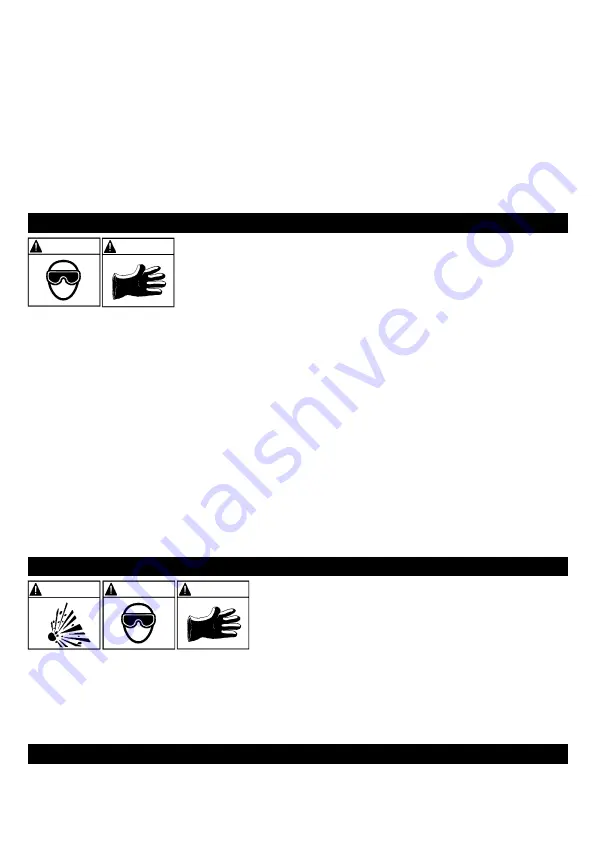
•
5
•
2.7
Have plenty of fresh water and soap nearby, in case battery acid contacts
your skin, clothing or eyes.
2.8
Wear complete eye and body protection, including safety goggles and
protective clothing. Avoid touching your eyes while working near the battery.
2.9
If battery acid contacts your skin or clothing, immediately wash the area with
soap and water. If acid enters your eye, immediately flood the eye with cold
running water for at least 10 minutes and get medical attention right away.
2.10
If battery acid is accidentally swallowed, drink milk, the whites of eggs or
water. DO NOT induce vomiting. Seek medical attention immediately.
3. PREPARING TO CHARGE
RISK OF CONTACT WITH BATTERY ACID. BATTERY ACID IS A
HIGHLY CORROSIVE SULFURIC ACID.
3.1
If it is necessary to remove the battery from the vehicle to
charge it, always remove the grounded terminal first. Make sure all
of the accessories in the vehicle are off, to prevent arcing.
3.2
B
e sure the area around the battery is well ventilated while the battery is being charged.
3.3
Clean the battery terminals before charging the battery. During cleaning, keep airborne
corrosion from coming into contact with your eyes, nose and mouth. Use baking soda and
water to neutralize the battery acid and help eliminate airborne corrosion. Do not touch
your eyes, nose or mouth.
3.4
Add distilled water to each cell until the battery acid reaches the level specified by the
battery manufacturer. Do not overfill. For a battery without removable cell caps, such as
valve regulated lead acid batteries (VRLA), carefully follow the manufacturer’s recharging
instructions.
3.5
Read, understand and follow all instructions for the charger, battery, vehicle and any
equipment used near the battery and charger. Study all of the battery manufacturer’s
specific precautions while charging and recommended rates of charge.
3.6
Determine the voltage of the battery by referring to the vehicle owner’s manual and make
sure that the output voltage selector switch is set to the correct voltage. If the charger has
an adjustable charge rate, charge the battery in the lowest rate first.
3.7
Make sure that the charger cable clips make tight connections.
4. CHARGER LOCATION
RISK OF EXPLOSION AND CONTACT WITH
BATTERY ACID.
4.1
Locate the charger as far away from the battery as
the DC cables permit.
4.2
NEVER place the charger directly above the
battery being charged; gases from the battery will corrode and damage the charger.
4.3
Do not set the battery on top of the charger.
4.4
NEVER allow battery acid to drip onto the charger when reading the electrolyte specific
gravity or filling the battery.
4.5
Do not operate the charger in a closed-in area or restrict the ventilation in any way.
5. DC CONNECTION PRECAUTIONS
5.1
Connect and disconnect the DC output connectors only after removing the AC plug from
the electrical outlet. NEVER allow the connectors to touch each other.
5.2
Attach the connectors to the battery and chassis, as indicated in sections 6 and 7.
WARNING
WARNING
WARNING
WARNING
WARNING
Summary of Contents for BBCE24-10
Page 110: ...110 BBCE24 10...
Page 111: ...111 1 1 1 1 2 8 1 3 1 4 1 5 SNA Europe 1 6 1 7 ampere AC 8...
Page 112: ...112 1 8 1 9 1 10 1 11 1 13 1 14 46 cm 18 inches AC 1 12 W...
Page 113: ...113 2 2 1 2 2 2 3 2 4 24V AGM 20 230Ah 2 5 2 6 2 7 2 8 2 9 10 2 10...
Page 114: ...114 3 3 1 3 2 3 3 3 4 VRLA 3 5 3 6 3 7 4 4 1 DC 4 2 4 3 4 4 4 5 5 DC 5 1 DC AC 5 2 6 7...
Page 122: ...122 18 230V AC 50Hz 3 2A 24V 10A IP20 19 BBCEC2 BBCER2...
Page 137: ...137 BBCE24 10 WEEE...
Page 138: ...138 1 1 1 1 2 8 1 3 1 4 1 5 SNA Europe 1 6 1 7 8 1 8...
Page 139: ...139 1 9 1 10 1 11 1 13 1 14 46 18 1 12...
Page 140: ...140 2 2 1 2 2 2 3 2 4 AGM 24 20 230 2 5 2 6 2 7 2 8 2 9 10 2 10...
Page 141: ...141 3 3 1 3 2 3 3 3 4 VRLA 3 5 3 6 3 7 4 4 1 4 2 4 3 4 4 4 5 5 5 1 5 2 6 7...
Page 144: ...144 10 1 2 3 4 5 6 7 1 2 3 4 5 6 7 11 5 EN FR ES DE SE ITA 12 BBCE24 10 12 20 230 6 7...
Page 150: ......






































